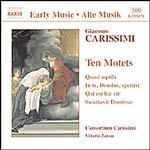
Carissimi - Ten Motets
 $25.00
Out of Stock
$25.00
Out of Stock6+ weeks add to cart
Carissimi - Ten Motets
Consortium Carissimi, Vittorio Zanon
[ Naxos Early Music / CD ]
Release Date: Wednesday 15 May 2002
This item is currently out of stock. It may take 6 or more weeks to obtain from when you place your order as this is a specialist product.
These motets are among the jewels of 17th-Century Italian-Church music
"The singing on this release is excellent...the playing is so...The notes by Garrick Comeaux appear in English, French, German, and Spanish. The Latin texts are translated into English in the booklet."
- Loewen American Record Guide January/February 2002
"This new recording has sufficient merit to recommend it, especially to those who enjoyed its predecessor."
- Fabrice Fitch Gramophone November 2001
Born in 1605, in the small Roman hillside town of Marino, Giacomo Carissimi began his career as a chorister and organist in Tivoli in the years between 1623-1627. In the two years that followed, he was organist and then maestro di cappella at the Cathedral of San Ruffino, which he left at the invitation of the rector of the Collegio Germanico Hungarico in Rome to become maestro di cappella of the already prestigious Basilica of Sant'Apollinare which was associated with the College. Here he would remain for the rest of his life. The Basilica of Sant'Apollinare had already established itself as a centre of excellence for liturgical music in Rome, and the presence of Jacomo, as he is remembered in archive documents, brought it even greater attention. Carissimi taught music to the students of the college and privately to such musicians as Kerll, Baudrexel, Bernhard and Charpentier. He also took part in the musical activity of the Confraternity of the Santissimo Crocifisso at San Marcello. Among the numerous proposals of employment made to him over the years, he only accepted Queen Christina of Sweden's offer in 1656 to become her maestro di cappella da camera, rejecting offers to serve as Kapellmeister at the court of the Archduke Leopold Wilhelm in Brussels and ignoring attempts to persuade him to succeed Claudio Monteverdi at the Basilica of San Marco in Venice. He died on 12th January 1674 and was buried in his beloved Basilica of Sant'Apollinare.
Carissimi's talent was soon recognised by his Roman contemporaries and brought him long-lasting admiration throughout Europe. Such success was not accorded his manuscript compositions, which he left to the college at his death. Pope Clement X, in fact, prohibited the lending, transfer, sale or publication of his music. Today almost all autograph manuscripts are lost, perhaps owing in part to the destruction resulting from the two French occupations of Rome. Those manuscripts which survive are copies, not autographs, which were produced solely for performance by Carissimi's students, providentially preserving a large number of his compositions.
All the manuscripts transcribed by Consortium Carissimi are, therefore, copies themselves, made by Carissimi's contemporaries, and consequently little information comes directly from the music other than the text itself as to where and in what circumstances this music was performed. At the Oratory of the Santissimo Crocifisso, the Confraternity of the same name was active from 1568 to 1725, creating a tradition of such excellence in performances of sacred music that its influence was fundamental for the musical genre known today as the Oratorio. This para-liturgical form consisted of Old and New Testament readings and a sermon, interspersed with vocal and instrumental music. From the simple Lauda, which was already common in the Spiritual Exercises at the Oratory of Filippo Neri (S. Maria in Vallicella), to the production of more elaborate and complex motets, the Oratory involved professional musicians and composers, who fully immersed themselves in the spiritual ferment of the Catholic Counter-Reformation. These artists not only produced beautiful music, but music which involved the listener in the content of the texts, edifying those assembled through the sense of hearing.
The motets we have chosen fully reflect the considerable variety in formal style, in colour, in linguistic expression and refined approach to the senses, thereby creating a small but comprehensive musical library. Whether these motets could be heard in the liturgies of Sant'Apollinare or in the Spiritual Exercises at the Oratorio del Crocifisso it is difficult to say. The compositional style and exclusive use of Biblical texts would lead us to consider seriously this second hypothesis. Carissimi's aesthetic genius in the compositional techniques of the time sets the standard for his tendency towards innovative musical language. After several years of study of these texts we have been able to trace almost all to their literary sources. Only in a few instances have we been able to identify their actual authors. The textual sources may be liturgical, Biblical, patristic writings or poetical compositions or combinations of all four.
Tracks:
Surgamus, eamus, properemus
01. Surgamus, eamus, properemus 05:28
Qui est hic vir
02. Qui est hic vir 06:58
O vos populi
03. O vos populi 04:33
In te, Domine, speravi
04. In te, Domine, speravi 09:08
Lucifer
05. Lucifer 05:09
O vulnera doloris
06. O vulnera doloris 04:44
Quasi aquila
07. Quasi aquila 10:44
In coena Domini (Lamentationses Jeremiae Prophetae)
08. In coena Domini (Lamentationses Jeremiae Prophetae) 06:22
Qui tandem sunt mundi deliciae
09. Qui tandem sunt mundi deliciae 04:14
Suscitavit Dominus
10. Suscitavit Dominus 06:43

